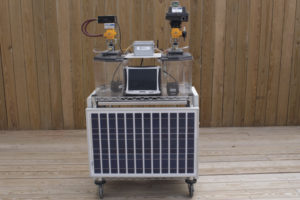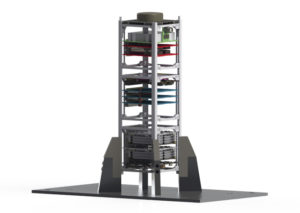West Virginians are designing and manufacturing ground-breaking technology for a variety of industries and uses that will have far-reaching impacts from under the Earth’s surface to beyond its atmosphere.
While West Virginia has more often than not been defined by its role as an energy producer, the Mountain State is more than just coal and natural gas. Its citizens have a long history of standing eye to eye with obstacles, and their resolve to overcome challenges has instilled in them the tools and instincts that characterize innovators and entrepreneurs. They have a drive to succeed, and when there is no road to follow, they blaze a new path and make their own success.
This natural tendency toward innovation is likely one of the reasons why three West Virginia companies—Aridea Solutions, Aurora Flight Sciences and TMC Technologies—are creating ground-breaking technological advances for industries like natural gas and aerospace. Their products are being designed and manufactured in the Mountain State and will have far-reaching impacts, from pipelines underground to the International Space Station and beyond.
Aridea Solutions’ Pneumatic Actuated Valve System

A demo version of Aridea Solutions’ pneumatic actuated valve system.
By Alicia Elkin
Internet of Things technology, or IoT, was the concept that inspired the start of Aridea Solutions, a West Virginia-based company that aims to deliver solutions for managing environmental assets while protecting natural resources. One such solution, the pneumatic actuated valve system, reduces response time to potential leaks along secluded pipelines, as well as costs associated with operating natural gas pipelines.
“On many pipelines today, the valve systems use manual actuation, which requires long response times that can be detrimental to people, property and the environment,” says BJ Evans, co-founder and managing director for Aridea Solutions. “In the unlikely event of a leak or explosion, our remote actuation system can help bring situations under control more quickly, thus reducing damages.”
Valves along isolated oil and gas pipelines are expensive to operate due to lack of power and communications infrastructure. The pneumatic actuated valve system utilizes IoT—the development of the internet in which everyday objects have connectivity—and low-power micro-controllers that enable the activation of valves via the internet.
According to Rob Moore, director of engineering for Aridea Solutions, the pneumatic actuated valve system uses either the high gas pressure already present in the lines or a solar-powered compressor to store the air needed to activate the valves. Once the necessary air or gas pressure is available, the system allows a remote user to control valves securely from any device connected to the internet.
“We saw a challenge and need in the oil and gas industry to be able to remotely activate valves in areas where traditional communications and power are not available,” says Moore. “We felt our technology of low-powered, long-range communications could greatly aid in this need.”
This year, the pneumatic actuated valve system won Aridea Solutions the 5th Annual Shale Gas Innovation Contest, an annual competition conducted to help drive innovation aimed at fully developing the shale gas industry in the region.
“As West Virginia looks at ways to move our abundant natural gas to markets where it is needed, it is important that we carry it out safely and efficiently,” says Evans. “The pneumatic actuated valve system will allow oil and gas pipeline operators to have the ability to quickly respond to emergencies, as well as better utilize their resources and manage pipeline assets.”
Aurora Flight Sciences’ LightningStrike VTOL X-Plane
By Katlin Swisher
The sky’s the limit for Aurora Flight Sciences, creator of the new LightningStrike Vertical Take-off/Landing Experimental Plane (VTOL X-Plane). The aircraft, which will be assembled in Aurora’s Bridgeport, WV, manufacturing facility, will be the first in history with an electric-drive system and hybrid-electric propulsion ducted fans that will also offer high efficiency in both hover and high-speed forward flight.
In addition to completing the plane’s assemblies, the Bridgeport facility will build its carbon fiber parts. The company’s West Virginia branch employs 120 engineers, technicians and other staff and specializes in complex aerostructure assemblies and carbon fiber parts for military and commercial planes.
“The LightningStrike VTOL X-Plane is a game changer in that it has plane-like speed with the agility of a helicopter,” says Eric Thompson, general manager of Aurora’s Bridgeport facility. “Long runways are not always easy to find, and this aircraft can land anywhere a helicopter can land while being much quieter with electrically distributed propulsion.”
Weighing in at 12,000 pounds, which is comparable to a standard commercial or business jet, the LightningStrike VTOL X-Plane is 38 feet long with a 61-foot wingspan. The product of a Defense Advanced Research Projects Agency (DARPA) contract, the goal of the research and development of this plane is to increase efficiencies, reduce noise and use the technology for different platforms, such as manned and unmanned flights.
The LightningStrike VTOL-X is part of DARPA’s VTOL X-Plane project. Initiated in 2013, Aurora Flight Sciences was one of four companies chosen for phase one of the DARPA contract. After evaluation, Aurora Flight Sciences was selected as the sole recipient for phases two and three, which encompass fabrication and assembly of one aircraft up through flight tests. In partnership with Rolls-Royce and Honeywell, phases one through three totaled $105 million.
“The component of phase one that helped win phases two and three of the contract was the 20 percent scaled model of the full-scale model,” says Carl Schaefer, program manager for the LightningStrike VTOL X-Plane. “This model demonstrated to DARPA that the avionic system works and ensured the design has all of the necessary components and capabilities to build upward from there.”
The full-scale plane is scheduled to be completed in late 2017 and flight tested in early 2018.
“The LightningStrike VTOL-X could potentially be used in every sector—commercial, private and military,” says Thompson. “The intent of this plane is to push the limits of the VTOL technology. Once we prove the technology works, it can really go in any platform.”
TMC Technologies’ STF-1 Satellite

An STF-1 model showing system placement and sizing.
By Scott Zemerick
TMC Technologies, in partnership with NASA’s Independent Verification & Validation (IV&V) program, West Virginia University (WVU) and NASA’s West Virginia Space Grant Consortium, has been selected by NASA’s CubeSat Launch Initiative to design and construct the first space satellite from the Mountain State.
West Virginia’s CubeSat—a small, miniaturized space satellite about the size of a loaf of bread that performs space and earth science—will be launched by NASA in late 2017. This satellite, named Simulation-To-Flight 1 (STF-1), will focus on TMC software simulation capabilities and demonstrate how simulation of space hardware can lower overall satellite mission risks and ensure mission success.
The STF-1’s primary objective is to be able to run spacecraft flight software on a laptop computer and have it think it is really in space. The major benefits of this capability are the ability to perform flight software development earlier, aid in the verification and validation process and begin the mission planning activities sooner. In addition to TMC simulation capabilities, STF-1 will contain WVU science payloads aimed at space weather research, navigation and radiation-tolerant materials.
TMC and its partners submitted the STF-1 CubeSat proposal in November 2014. In February 2015, NASA announced that STF-1 had been chosen as one of the 14 selected. West Virginia was the only rookie state chosen by NASA to build the satellite.
“STF-1 is very important for West Virginia,” says Justin Morris, NASA IV&V STF-1 lead. “It demonstrates cutting-edge technology being built by West Virginia natives in West Virginia.”
STF-1 is scheduled to launch on a brand-new rocket named the Electron, which is currently being built and tested by Rocket Labs USA for NASA. The launch is planned to have an inclination of 85 degrees and an altitude of 500 km. This means STF-1 will travel pole to pole around Earth every orbit, which takes 90 minutes. The STF-1 orbit will be about 100 km higher than the International Space Station.
TMC is responsible for the satellite’s hardware and flight software development. The satellite and flight software are currently undergoing development and testing in Fairmont, WV. When finished, STF-1 will be an autonomous space satellite capable of performing various science missions.
“TMC is proud that the STF-1 CubeSat is being designed and built in West Virginia,” says Wade Linger, president of TMC. “We are excited that our software simulation work for the NASA IV&V program can be leveraged for small space satellites.”
TMC firmly believes software simulation for NASA missions will continue to improve safety and reliability while making cost-effective use of taxpayer dollars.



